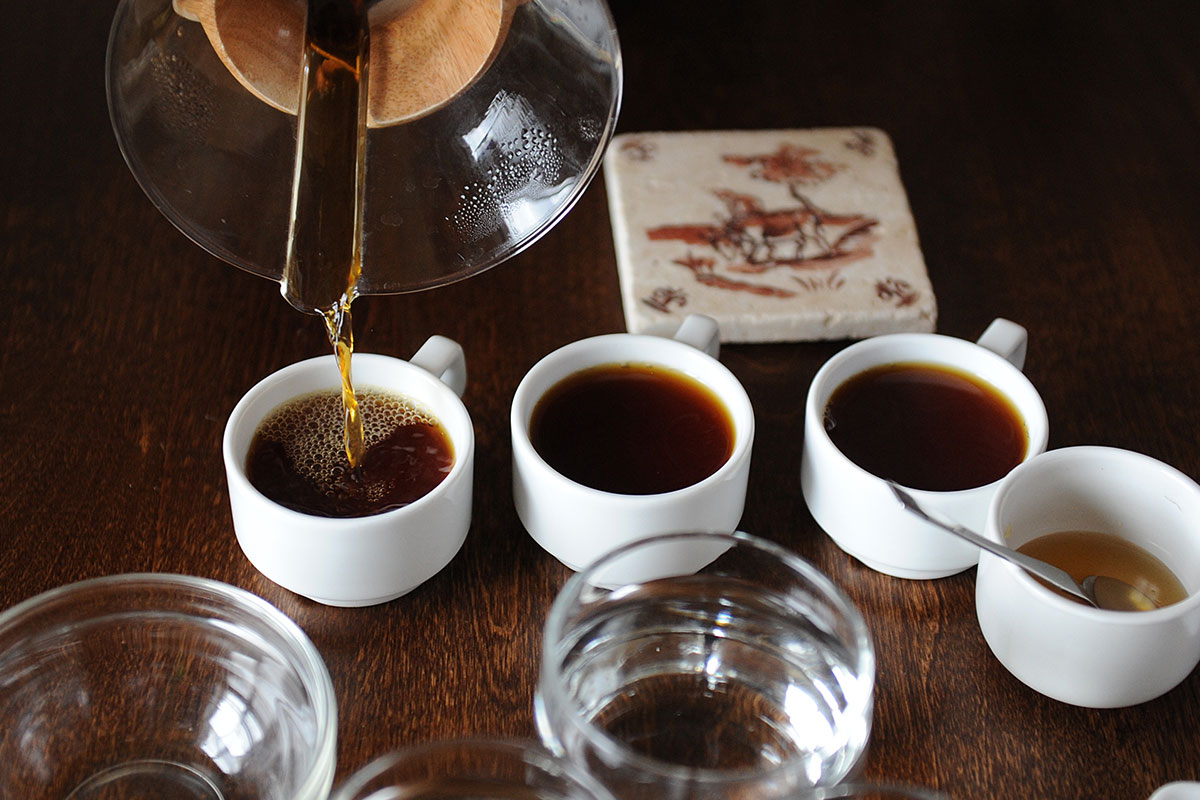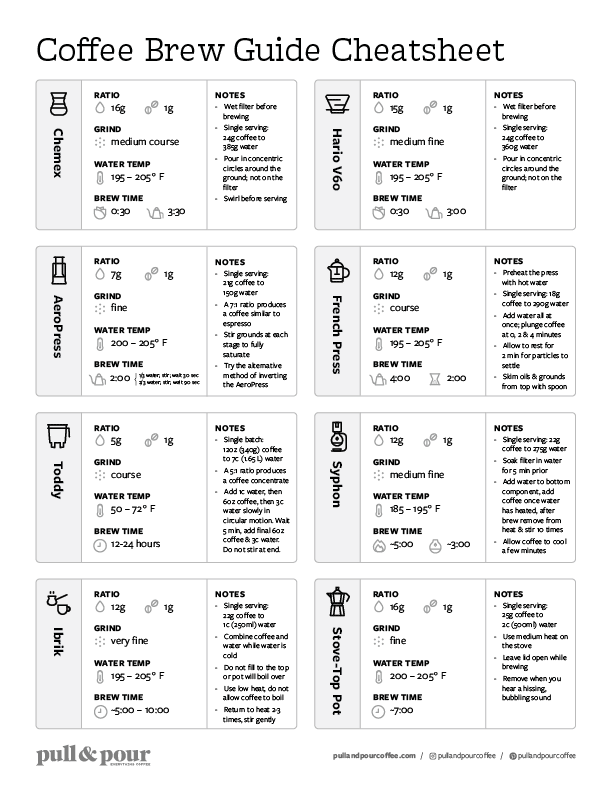Tasting coffee can be pretty subjective. A lot of the descriptions on coffee bags are individual to the roasters and are really geared more towards marketing. Did they really taste “cocoa melting into sweet berries” or does that just sound delicious and will make someone want to try that coffee? That said, there are some traits that, when broken down, can help determine a good cup of coffee. The more coffee you taste, the more of these characteristics you’ll begin to identify.
I remember when I first started drinking coffee that I couldn’t identify any of these traits. After hundreds and hundreds of cups of different kinds of coffee, however, I’ve begun to identify the different traits more clearly. It’s a journey, though, and I’m continuing to refine my palette and tasting skills with every cup of coffee I try. Below is a quick summary of the different traits I use when reviewing coffee.
How I review coffee based on these 10 attributes
I use the 10 attributes listed below when reviewing any coffee. This method helps to break down the coffee into its component parts and focus on each area when tasting the coffee versus trying to assign a random number between zero and 10 to a coffee. The attribute scores are added together and then divided by 10 to come up with the overall score.
Below each description of the tasting attribute, I’ve included some notes on how I use the attribute in my own scoring.
Aroma
Simply put, aroma is how the coffee smells. (Technically, this is a combination of fragrance, or the smell of dry coffee, and aroma, or the smell of brewed/wet coffee, but for the sake of simplicity, we’ll call all of that aroma.) Your sense of smell plays a large role in how you taste, and because of this, the aromas found in coffee can impact the overall taste of the cup quite a bit. According to Garrett Oden, writing on JavaPresse, “Brewed coffee has over 800 aromatic compounds, beating out every other kind of beverage, including wine, which only has about 250.”1
My Thoughts on Aroma
Aromas can fade quickly, so I am always sure to smell the coffee at multiple times throughout the tasting process. I begin by smelling the aromas when I initially open the bag of coffee, again after grinding the coffee, a third time as the coffee is brewing or has just brewed, and finally before taking my first sip. At each step, different aromas can present themselves or disappear. Coffees that have strong aromatics in each step score the highest, especially if the aromatics are complex with multiple flavor notes present.
Body/Mouthfeel
This is called “mouthfeel” because it essentially describes how the coffee feels in your mouth. Is the coffee light and tea-like or rich, creamy, and heavy? Both options can be good, depending on the coffee and your personal preference. One way I’ve heard to think about mouthfeel is the difference between skim milk, whole milk, and heavy cream—each one has a very different feel in the mouth. Coffee is the same way. Light, medium, and full or heavy are words usually used to describe the body of a coffee.
Body and mouthfeel are technically different (mouthfeel refers to the textures/sensation of the coffee in your mouth and on your tongue, while body focuses on the weight and composition of the coffee on the tongue), but they are so similar that they can really be interchangeable.
My Thoughts on Body/Mouthfeel
As with many of the other tasting areas, the body can be tricky because there isn’t necessarily a right or wrong description you’re looking for. One coffee could have a heavy, creamy mouthfeel and another a light mouthfeel, but both could score equally high. In addition, the way the coffee is brewed (pour over, cupping, etc.), the filter used, and other factors can all have an impact on the mouthfeel. Generally, I try to think in terms of thin or heavy, light, or thick and creamy. I generally deduct points if I notice a mouthfeel that feels a bit thin or astringent or that doesn’t seem right given the coffee’s profile.
Flavor
This one is probably the easiest to describe. Flavor essentially describes how a coffee tastes. Other areas like sweetness and complexity overlap here a bit, but this area specifically focuses on the taste of the coffee.
My Thoughts on Flavor
When thinking about the flavor of a coffee, I always begin by trying to think about what the coffee reminds me of. What foods or drinks have similar qualities and tastes? While I have preferences when it comes to flavor, fitting within my preferences doesn’t effect the rating. Instead, I try to taste any unpleasant flavors, unwanted bitterness, or other flavors that shouldn’t be in the final cup. If any undesirable flavors are found, I subtract from the score.
Acidity/Brightness
Acidity always confused me when I first started tasting coffee. You don’t want acidic coffee, do you? While some acidity in coffee can be unpleasant and make the coffee sour, the acidity found in a good coffee helps give it its crispness and brightness. It’s what makes a coffee taste fruity and vibrant.
My Thoughts on Acidity/Brightness
The brightness of a coffee is one of the most important characteristics, in my opinion. For this score, I try to focus on the type of acidity I am tasting. Is it in your face like a lemon or grapefruit, or more subtle, like the malic acid of a Fuji apple? One isn’t necessarily better than another, though a coffee with balanced, complex acidity always scores best. If there is overpowering sourness or other acidity that feels out of place or unwanted, I subtract from the score.
Balance
Balance refers to the harmony of many of the other areas in the scoring. It exists between aromatics, flavors, sweetness, and aftertaste and addresses how well they each work together. A coffee that is balanced has a unity among the aromas, flavors, and aftertaste; the entire coffee comes together. A well-balanced cup of coffee is many times referred to as “smooth.”
My Thoughts on Balance
Balance allows you to take a step back and make sure the entire coffee works together. While in some traits I focus in on specific areas (e.g., aromatics and fragrance for the aroma), with the balance score, I try to look at the coffee as a whole and score how it all comes together.
Cleanliness
Having a clean cup of coffee essentially means that there are no flavor defects present and there is uniformity between cups of coffee. The coffee is smooth and there are no specific flavors or other attributes that stick out as off-putting.
My Thoughts on Cleanliness
Part of the reason I always try a coffee a few times before finalizing the score is that I want to make sure it is consistently the same and that there aren’t any astringent flavors that come through in some of the brews. If with each brew the flavors align and there are no issues, a coffee scores well in this area.
Sweetness
In general, sweetness is a very desirable trait in coffee. This doesn’t refer to any added sugars or sweetness in the coffee, but instead describes the flavor compounds that come together during the roasting process to create a perceived sweetness that helps to balance the natural bitterness of coffee. When tasting sweetness in coffee, you need to step outside of thinking of it as “sugar.” Instead, the sweetness in coffee usually pairs with the flavor profile. For naturally processed African coffees, that usually looks like fruity sweetness; in many South American coffees, it is either a floral or rich caramel/chocolate sweetness.
My Thoughts on Sweetness
As with other tasting areas, when evaluating the sweetness in coffee, I try to identify what the coffee reminds me of and break the sweetness down from there. If I can identify sweetness that helps balance the coffee, the coffee scores well in this area.
Aftertaste
Aftertaste is the taste you are left with—any lingering flavors—after finishing a sip of coffee. It is really a combination of the coffee’s acidity, sweetness, bitterness, aromas, and body/mouthfeel mixing together. Sometimes you taste additional flavor notes that weren’t present in the initial sip, which is great and enhances the overall cup. Sometimes, though, there is lingering bitterness or a dry feeling in the mouth; both of those detract from the experience.
My Thoughts on Aftertaste
For the aftertaste score, I focus on what taste or feeling lingers in my mouth. After taking a sip of coffee, I breathe back through my mouth and think about the flavors I experience and the feeling left in my mouth. Coffees that have additional flavor notes that come through after the last sip and leave your mouth feeling ready for more score well here. Coffees with lingering bitterness or that leave your mouth feeling dry lose points.
Complexity
When a coffee is described as complex, it simply means there is a complexity to the aromatics, flavors, and other attributes in the coffee; a single word could not describe the taste sensations when drinking it. While complexity doesn’t necessarily guarantee a coffee is good, it is a good indicator.
My Thoughts on Complexity
When tasting coffee, I try to break down the individual elements of the coffee that all come back together to define its complexity. A coffee that has different traits (aromatics, flavors, etc.) that evolve as you drink the coffee score well in this area.
Flexibility
While this isn’t usually an attribute used to score coffee among professionals, I find how flexible a coffee is among brew methods to be an important factor in its overall score. Some coffees excel in espresso but fall short in pour over; some suffer from the opposite issue. I believe truly excellent coffees should be versatile and work across an array of brew methods.
My Thoughts on Flexibility
I try every coffee I review with at least two brew methods—and usually three or four. I try to see how the flavors, mouthfeel, and other traits change with the different brew methods and if the coffee can hold up when made in different ways. Coffees that excel in each brew method score high in this area. Coffees that excel in some of the brew methods but fall short in others score lower.
Conclusion
Tasting and reviewing coffee is one of my favorite parts of running Pull & Pour. There is such a wide variety of truly amazing speciality coffees being produced and roasted today that there is never a shortage of great coffees to try. If you have a coffee you think I should try or if you are are a roaster and have a sample you would like for me to review on the site, please get in touch.
References
- https://www.javapresse.com/blogs/enjoying-coffee/how-to-taste-coffee-aroma
Other References
- https://www.thecoffeeconcierge.net/how-i-review-whole-bean-coffee/
- https://www.javapresse.com/blogs/enjoying-coffee/how-to-taste-coffee-aroma
- https://bluebottlecoffee.com/frequency/beginner-s-guide-to-coffee-tasting
- https://www.roastycoffee.com/taste-coffee/

